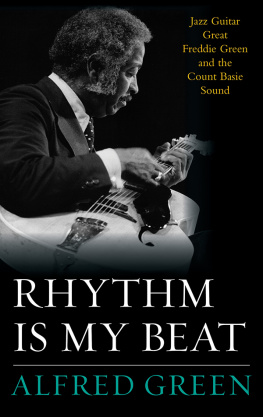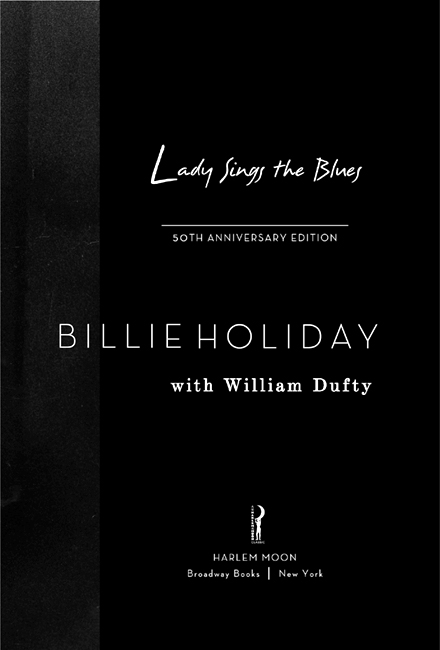Published by Harlem Moon, an imprint of Broadway Books, a division of Random House, Inc.
A hardcover edition of this book was originally published in 1956 by Doubleday, a division of Random House, Inc. It is here reprinted by arrangement with Doubleday.
LADY SINGS THE BLUES. Copyright 1956 by Eleanora Fagan and William F. Dufty. Introduction copyright 2006 by David Ritz. Discography copyright 2006 by David Ritz. All rights reserved. No part of this book may be reproduced or transmitted in any form or by any means, electronic or mechanical, including photocopying, recording, or by any information storage and retrieval system, without written permission from the publisher. For information, address: Broadway Books, a division of Random House, Inc.
HARLEM MOON, BROADWAY BOOKS, and the HARLEM MOON logo, depicting a moon and a woman, are trademarks of Random House, Inc. The figure in the Harlem Moon logo is inspired by a graphic design by Aaron Douglas (18991979).
Visit our Web site at www.harlemmoon.com
The Library of Congress has cataloged the hardcover as:
Holiday, Billie, 19151959.
Lady sings the blues.
1. Holiday, Billie, 19151959. 2. SingersUnited StatesBiography.
3. Holiday, Billie, 19151959. III. Title.
ML420.H58A3 1984 784.5300924[B] 83-22014
eISBN: 978-0-307-78616-6
v3.1
INTRODUCTION
I love this book.
I loved it when I read it as a jazz-crazed thirteen-year-old. I loved it when, at age sixty-two, I read it again last month for probably the fifth time. I am deeply grateful for the books existence, not merely because I find salty beauty in its prose and funky poetry in its candor, but because it brings me closer to Billie. I never met Billie, except in her songs and in the pages of this book, which, as it turned out, changed my life.
After that first reading, I told my dad, who had introduced me to Billies music, that I felt as if Billie had been talking directly to me, narrating her story across her kitchen table. But I was confused by a credit on the cover: As told to William Dufty.
Whos William Dufty? I wanted to know.
The man who wrote the book, my dad explained.
No, Billie wrote it, I said. Shes the one speaking to you.
Im not sure Billie has the literary background to write a book. So Dufty interviewed her and wrote the book in her voice.
Did he get to go over to her house?
I imagine so. Its his job.
Well, thats the job I want.
Five decades later, thats the job I have.
Thirty years ago, when I started in the business of ghostwriting, a much misunderstood and underappreciated art form, I had two modelsLady Sings the Blues and The Autobiography of Malcolm X. Were it not for these books, in which Dufty and Alex Haley skillfully and even mystically sculpt voices of undeniable authenticity, I would have never grasped the importance of getting out of the way and letting the artist live on the page.
Because it preserves the living voice of Billie Holiday, this fiftieth-anniversary edition of Lady Sings the Blues is cause for celebration. And because it has been the object of intense scrutiny, skepticism, and criticism, its longevity is testimony to one of its most endearing qualities: emotional power. The proof of that power is in Ladys appeal. Like Billies music, Billies book has won favor with generation after generation of fans. It is as a fannot as a writer or expertthat I sing its praises. It is as a fan that I cherish its ongoing availability to all those who now love, and will surely come to love, this mysterious and brilliant woman.
Billie has been blessed with a group of devoted students and scholars who have researched and reflected on her life. Each has approached her with passion, looking to explicate the entangled relationship between her art and her life. Each has begun with her music and Lady Sings the Blues. And even though the book has been castigated for inaccuracies and distortions, the book isand will always bethe starting point for any investigation into Billies life. Like it or not, this is how she viewed herself.
A little background:
Billie met Maely Bartholomew, then married to actor Freddie Bartholomew, in 1947. The women became friends, and for a period of time, Maely helped manage and book Billie. In the fifties, Maely remarried. Her new husband, William Dufty, was a journalist and editor at the New York Post. He, too, became a confidant of Billies, and, in fact, Billie became godmother to Bevan, son of William and Maely. In 1954, Bill Dufty and Billie began working on her life story. In 1955, a first chapter and outline were shopped to Doubleday editor Bill Barker, who promptly bought it. In 1956, the book was published with a cover price of $3.75. The title proposed by Dufty and HolidayBitter Cropwas deemed too negative by Barker. A compromise was reached. In its first year, Lady Sings the Blues sold a respectable 12,000 copies. At the same time, Billies producer Norman Granz issued a tie-in album, also called Lady Sings the Blues (title song written by Herbie Nichols and Billie) on his Verve label. That November, Billies Carnegie Hall performance incorporated readings by Gilbert Millstein from the book.
A woman named Linda Kuehl was so moved by a recording of that Carnegie Hall concert that, in her seventies, she conducted almost 150 interviews of people who knew the singer. In addition, she amassed a great wealth of documents. Sadly, Kuehl committed suicide before her Billie biography could be completed. Other writers, thoughsome utilizing Kuehls research, some nothave contributed to our appreciation of Billies remarkable character. These include John Chilton (Billies Blues: The Billie Holiday Story, 19331959), John White (Billie Holiday), Robert OMeally (The Many Faces of Billie Holiday), Stuart Nicholson (Billie Holiday), Donald Clarke (Wishing on the Moon: The Life and Times of Billie Holiday), Farah Jasmine Griffin (In Search of Billie Holiday: If You Cant Be Free, Be a Mystery), and Julia Blackburn (With Billie).
Some of these scholars complain that Billie wrote the book for money. Well, Billie also sang for money (as did everyone from Enrico Caruso to Ray Charles). The implication is that her monetary needs overwhelmed her literary integrity. I find the argument specious and, moreover, incompatible with the books tone of urgency and undeniable passion. There is nothing gratuitous or glib about her views of her harrowing childhood, her mother, her lovers, or her relationship to music, heroin, and the criminal justice system. You feel that shes writingthat shes opening her heartbecause she has to.
Billie was also accused of taking on the project only because she wanted a movie made from her life story. For a woman who renamed herself after a movie starBillie Dovethat hardly seems unreasonable. And though it took sixteen years for Hollywood to make Lady Sings the Blues, the movie, beyond its cinematic faults and musical virtues, accomplished what Billie had always wanted: It kept her legacy alive. In fact, the film enlarged her legacy to an ever widening and appreciative international audience. Her book does the same thing. It makes her accessible and, at least for me, lovable.
Another charge leveled at Lady is that Billie distorts the truth, that the book is largely inaccurate. In fact, scholars have proven this to be the case in some significant areas. (See Nicholsons, Clarkes, and OMeallys studies for specific instances.) But as Farah Jasmine Griffin so sensitively explains about







